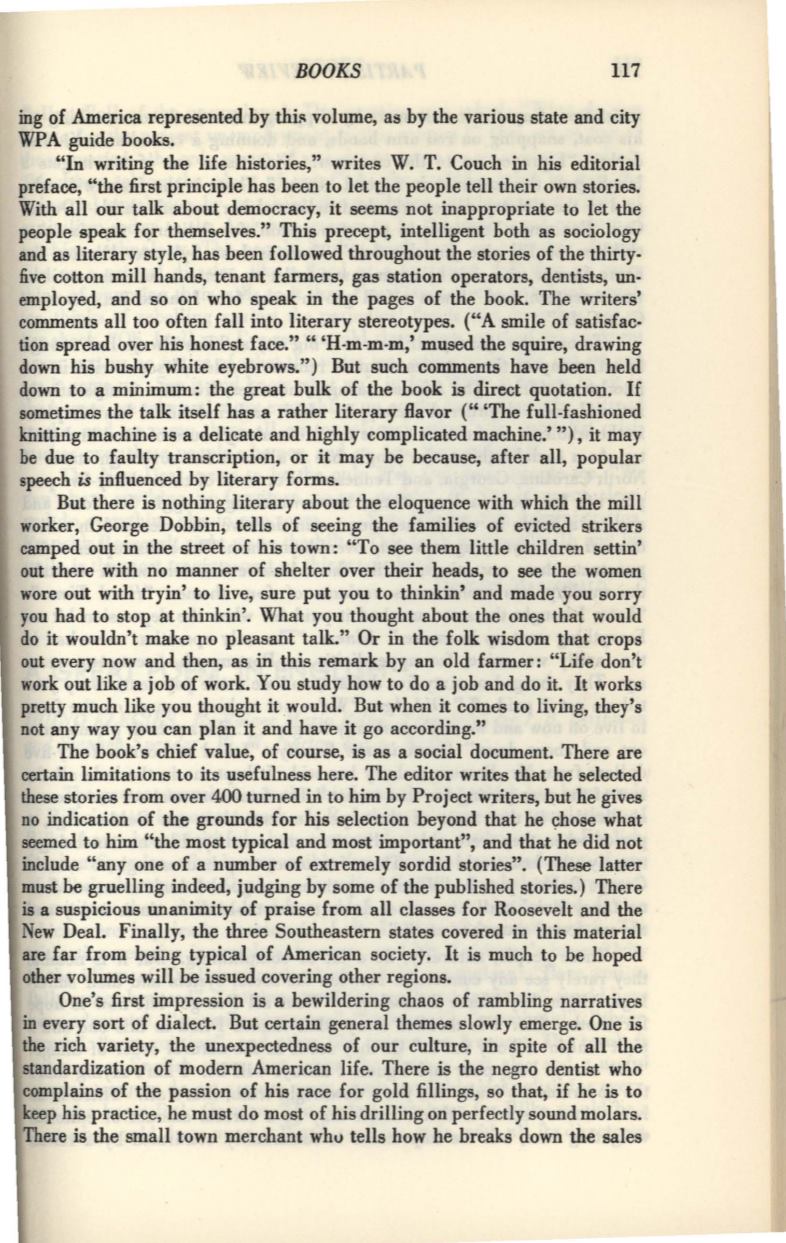
BOOKS
117
ing of America represented by thil' volume, as by the various state and city
WPA guide books.
"In writing the life histories," writes W. T. Couch in his editorial
preface, "the first principle has been to let the people tell their own stories.
With all our talk about democracy, it seems not inappropriate to let the
people speak for themselves." This precept, intelligent both as sociology
and as literary style, has been followed throughout the stories of the thirty·
five cotton mill hands, tenant farmers, gas station operators, dentists, un–
employed, and so on who speak
in
the pages of the book. The writers'
comments all too often fall into literary stereotypes. ("A smile of satisfac·
tion spread over his honest face." "'H-m-m-m,' mused the squire, drawing
down his bushy white eyebrows.") But such comments have been held
down to a minimum: the great bulk of the book is direct quotation.
If
sometimes the talk itself has a rather literary flavor ("'The full-fashioned
knitting machine is a delicate and highly complicated machine.'"),
it
may
be due to faulty transcription, or it may be because, after all, popular
speech
is
influenced by literary forms.
But there is nothing literary about the eloquence with which the mill
worker, George Dobbin, tells of seeing the families of evicted strikers
camped out in the street of his town: "To see them little children settin'
out there with no manner of shelter over their heads, to see the women
wore out with tryin' to live, sure put you to thinkin' and made you sorry
you had to stop at thinkin'. What you thought about the ones that would
do it wouldn't make no pleasant talk.'' Or in the folk wisdom that crops
out every now and then, as in this remark by an old farmer: "Life don't
work out like a job of work. You study how to do a job and do it. It works
pretty much like you thought it would. But when it comes to living, they's
not any way you can plan it and have it go according.''
The book's chief value, of course, is as a social document. There are
certain limitations to its usefulness here. The editor writes that he selected
these stories from over 400 turned in to him by Project writers, but he gives
no indication of the grounds for his selection beyond that he
~hose
what
seemed to him "the most typical and most important", and that he did not
include "any one of a number of extremely sordid stories". (These latter
must
be
gruelling indeed, judging by some of the published stories.) There
is
a suspicious unanimity of praise from all classes for Roosevelt and the
New Deal. Finally, the three Southeastern states covered in this material
are far from being typical of American society. It is much to be hoped
other volumes will
be
issued covering other regions.
One's first impression is a bewildering chaos of rambling narratives
in every sort of dialect. But certain general themes slowly emerge. One is
the rich variety, the unexpectedness of our culture, in spite of all the
standardization of modern American life. There is the negro dentist who
complains of the passion of his race for gold fillings, so that, if he is to
keep his practice, he must do most of his drilling on perfectly sound molars.
There is the small town merchant who tells how he breaks down the sales


